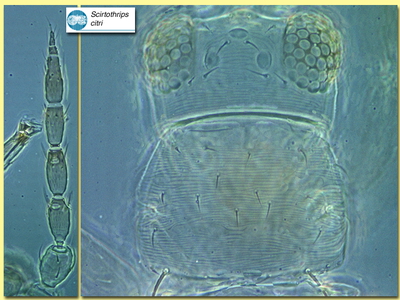Figures
Fig. 1 Antenna, head (dorsal) and pronotum
Fig. 2 Meso- and metanotum
Fig. 3 Fore and hind wing
Fig. 4 Head, thorax and abdomen
Fig. 5 Sternites III and IV
Fig. 6 Tergite VII and VIII (female)
Species
Scirtothrips citri Moulton
Biology
A major pest of citrus in California, breeding on young leaves and young fruits, this species is polyphagous and can be found on a range of native plants in that State.
Distribution
Although commonly considered to be restricted to California, individuals of what appear to be the same species have been seen from other parts of southern U.S.A. and also Mexico.
Recognition
Small pale thrips with very weakly shaded forewings and antennae; tergites and sternites each with no dark markings. Antennae 8-segmented, sense cones on III & IV forked and short. Head with one pair of setae in front of fore ocellus, and one pair within the triangle and just behind the fore ocellus; ocellar region with many transverse striae. Pronotum with many transverse striae, one pair of major posteromarginal setae. Metanotal sculptured striae forming reticulation, equiangular on anterior half, longitudinal on posterior half; median setae close to anterior margin. Forewing first vein with 3 setae on distal half, second vein with 3 widely spaced setae; posteromarginal cilia strongly wavy. Abdominal tergites with closely spaced rows of microtrichia on lateral thirds; median setae small and close together; tergite VIII with complete posteromarginal comb of microtrichia. Sternites with microtrichia only near lateral margins. Male tergite IX without lateral drepanae.
Related species
At least 60 species are known in this genus worldwide, mainly from tropical countries, and in Australia there are several more species as yet undescribed. From the more common Australian species, S. citri can be distinguished by the presence of sternal microtrichia only laterally.







